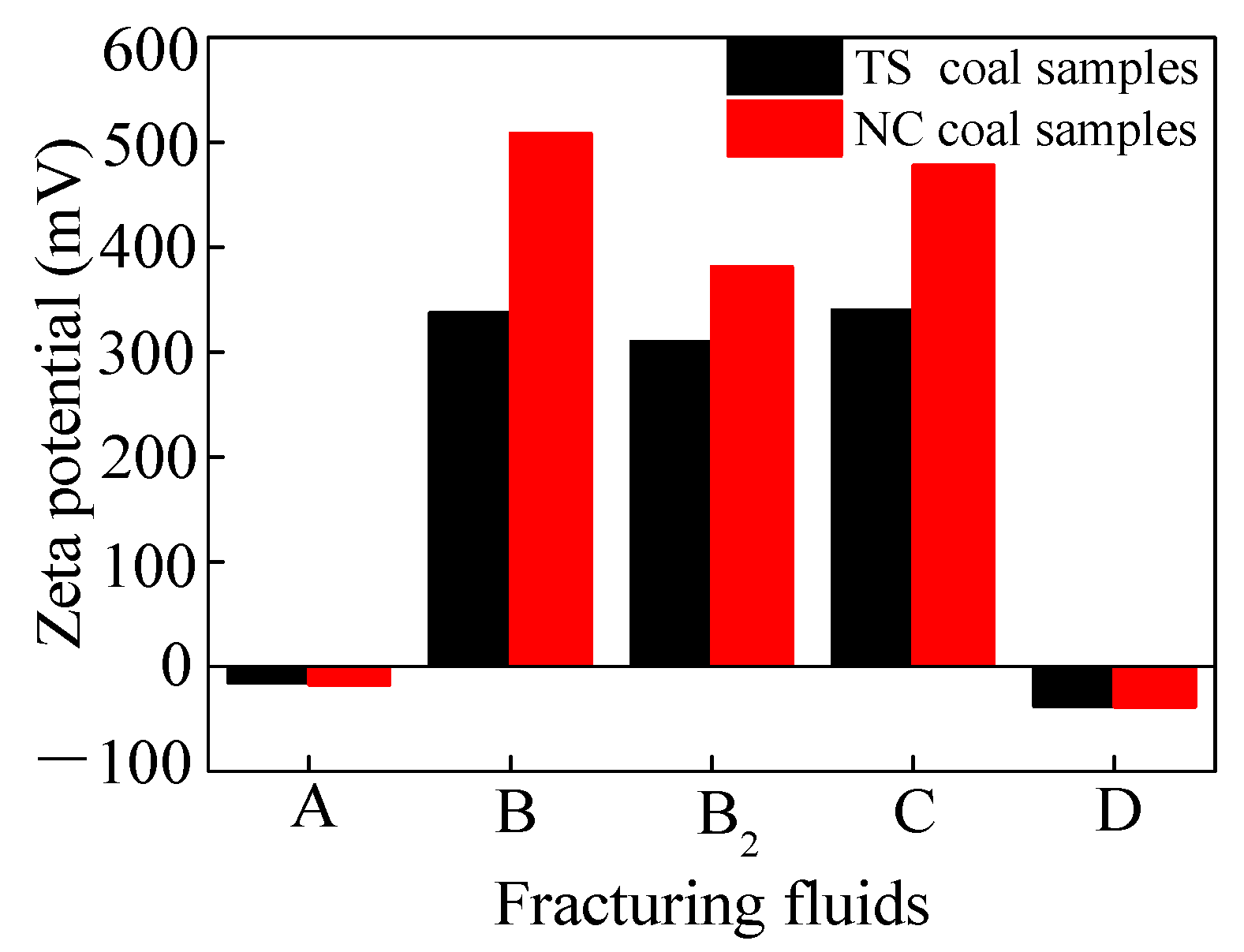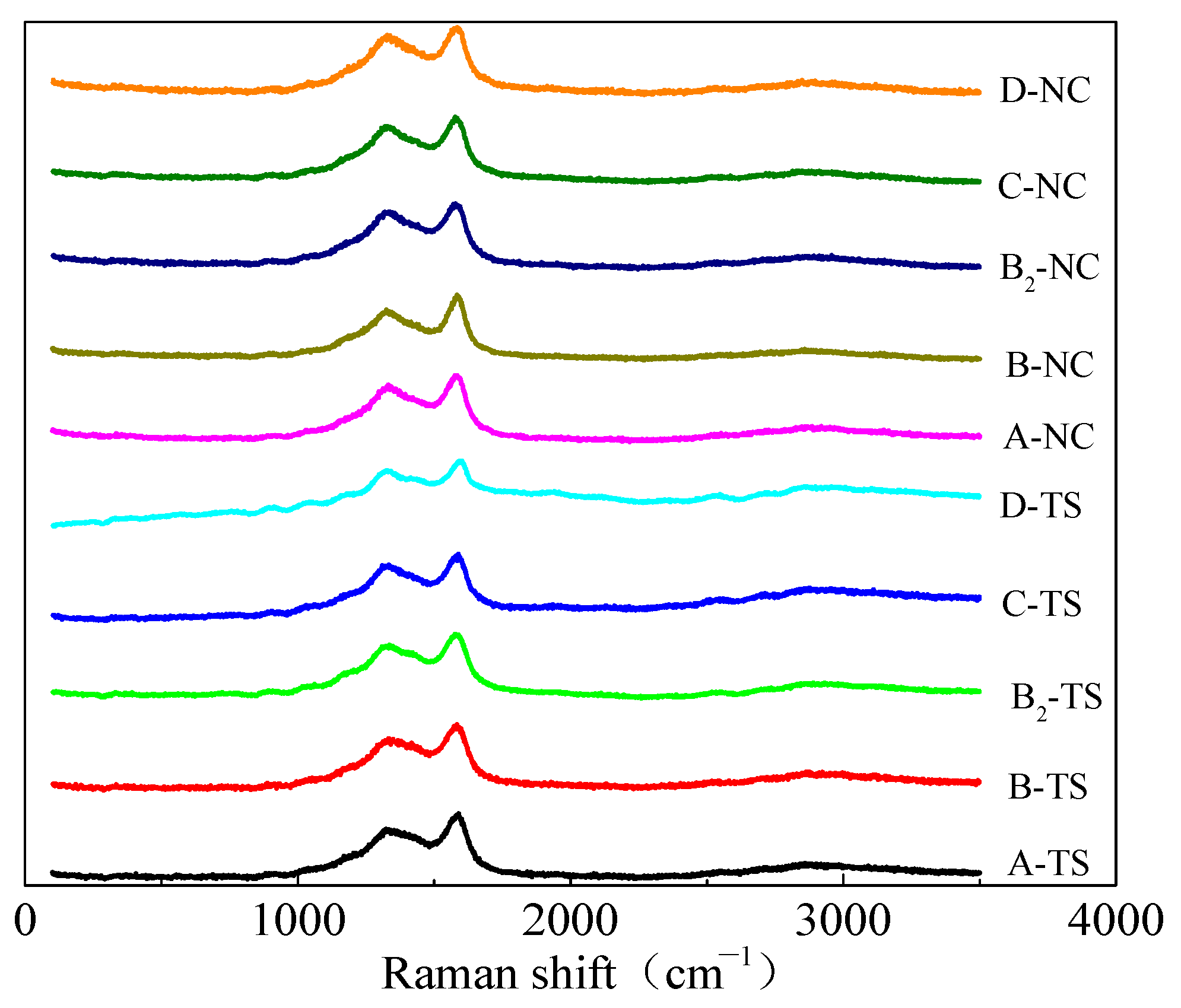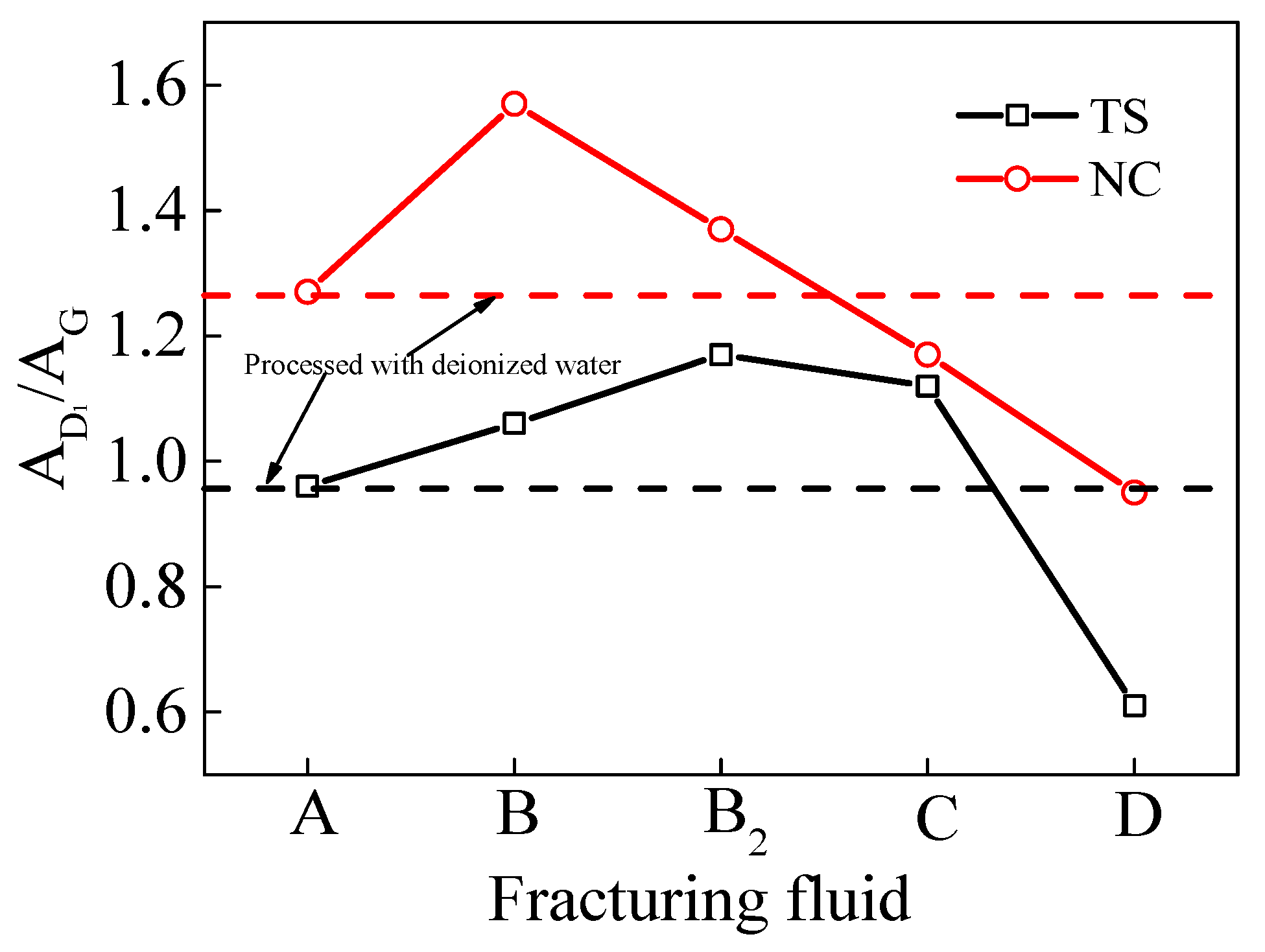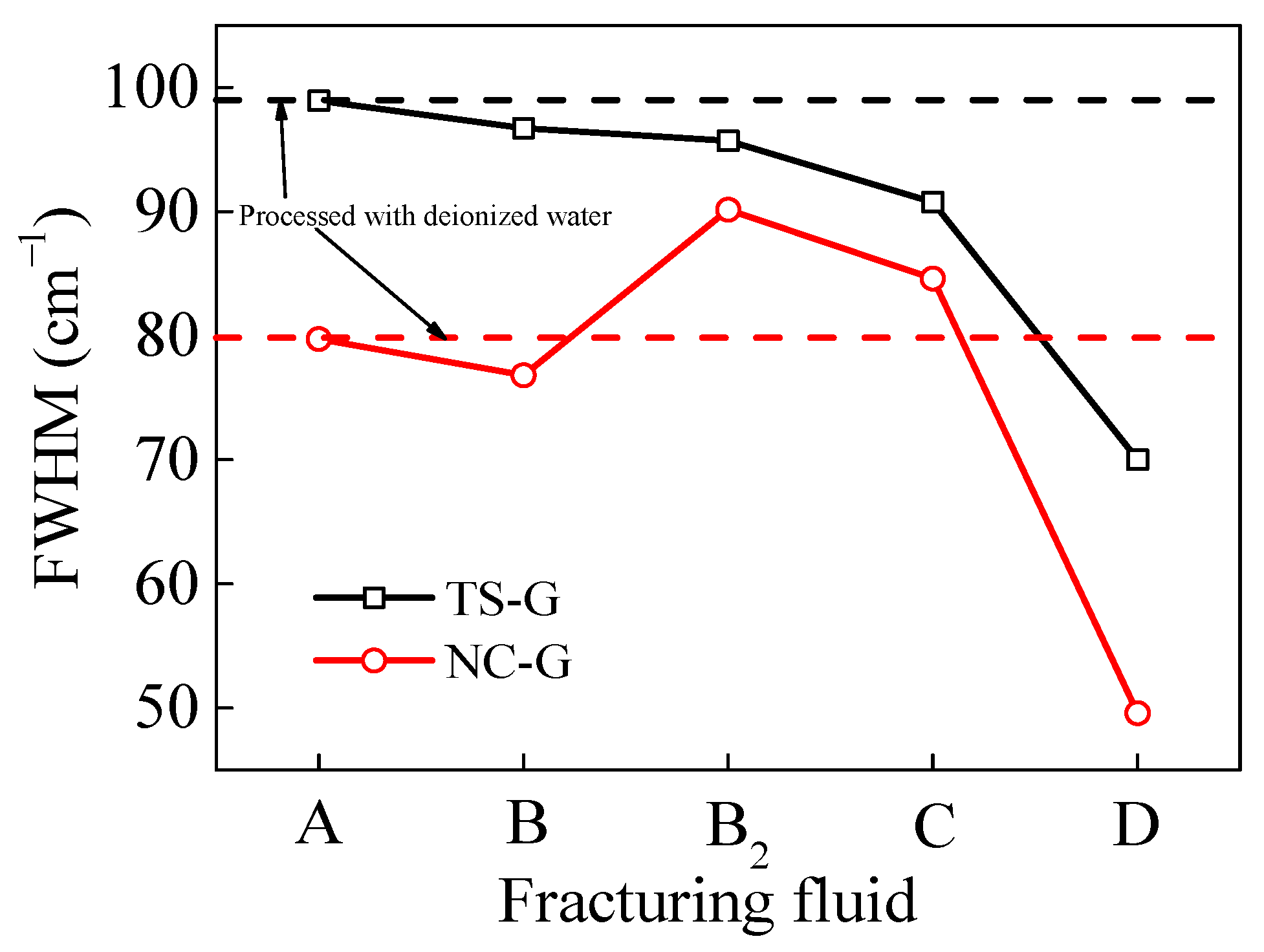Experimental Study and Analysis of Chemical Modification of Coal Surfaces by Viscoelastic Surfactant Fracturing Fluids
Abstract
1. Introduction
2. Materials and Methods
2.1. VESFF Preparation
2.2. Description of Coal Samples
2.3. Zeta Potential Test
2.4. FTIR Analysis
2.5. Raman Analysis
3. Results and Discussion
3.1. Zeta Potential of Coal Processed with VESFFs
3.2. Oxygenated Functional Groups on Coal Surfaces Processed with VESFFs
3.3. MS of Coal Processed with VESFFs
4. Conclusions
- (1)
- VESFFs B, B2, C, and D increased the electrical properties of the surface of the coal, and the electrostatic force between the pore wall and coal particles became greater than the Van der Waals force, leading to a repulsive effect beneficial for removing particles from the coal surface.
- (2)
- The coal samples subjected to treatment with VESFF C had more -Si-O- functional groups. VESFF C was more likely to penetrate into nanopores and thereby had a more pronounced effect on micropores and transition pores. The anionic VESs in VESFF D have oxidizing properties that destroy aromatic hydrocarbons and bridge bonds in the basic structural units on the surface of coal, generating stable carboxyl (-COOH) and anhydride groups.
- (3)
- The aromatic lamellae extension (La) in the aromatic crystal nuclei of the TS coal processed with VESFF D increased, resulting in an increase in micropore volume. VESFFs C and D were beneficial for increasing the aromatic layer extension (La) in the aromatic crystal nuclei of NC coal, resulting in an increase in micropore volume.
- (4)
- The treatment with VESFFs resulted in the aromatic ring spacing (d002) of the TS coal becoming smaller than that of the deionized-water-treated coal, decreasing in the following order: D > C > B2 > B. This indicates that VESFFs B, B2, C, and D all increased the micropore volume of the TS coal. The interlayer spacing (d002) of the aromatic rings in the macromolecules of the NC coal subjected to treatment with VESFFs B2 and C increased. This suggests that VESs with longer hydrocarbon chain lengths are not conducive to increasing micropores in NC coal.
Author Contributions
Funding
Institutional Review Board Statement
Informed Consent Statement
Data Availability Statement
Conflicts of Interest
References
- Gao, H.; Lu, J.; Zhang, Z.T.; Li, C.; Li, Y.H. Experimental study on the effect of freeze-thaw cycles on the mechanical and permeability characteristics of coal. Sustainability 2023, 15, 12598. [Google Scholar] [CrossRef]
- Li, S.H.; Wu, S.W.; Wang, B.; Zhang, J.Y.; Wang, L. Investigation of desorption and diffusion of gas within low-rank bituminous coal under moisture-stress constraints. Fuel 2024, 373, 132320. [Google Scholar] [CrossRef]
- Su, E.R.; Zhu, X.Y.; Chen, X.J.; Zou, Q.L.; Yang, K.; Chen, H.D.; Wei, J.Q. Analysis of methane diffusion on permeability rebound and recovery in coal reservoirs: Implications for deep coalbed methane-enhanced extraction. Phys. Fluids 2024, 36, 076622. [Google Scholar] [CrossRef]
- Yan, J.J.; Wang, F.; Li, Y.C.; Gao, Y.B.; Li, Z.G.; Liu, H.W. A feasibility study of coal seam water injection processes: The effects of coal porosity and mass flow rates of injected water on wetting radii. Energy Fuels 2020, 34, 16956–16967. [Google Scholar] [CrossRef]
- Wijaya, N.; Sheng, J.J. Mitigating near-fracture blockage and enhancing oil recovery in tight reservoirs by adding surfactants in hydraulic fracturing fluid. J. Pet. Sci. Eng. 2020, 185, 106611. [Google Scholar] [CrossRef]
- Shibaev, A.V.; Osiptsov, A.A.; Philippova, O.E. Novel Trends in the Development of Surfactant-Based Hydraulic Fracturing Fluids: A Review. Gels 2021, 7, 258. [Google Scholar] [CrossRef]
- Chee, S.C.; Hidayat, B.M.; Mohshim, D.F.; Zain, Z.M.; Chai, I.C.H.; Borhan, N.; Ismail, H.H.; Adam, M. Evaluation of anionic and non-ionic surfactant performance for Montney shale gas hydraulic fracturing fluids. J. Pet. Explor. Prod. 2021, 11, 1973–1991. [Google Scholar] [CrossRef]
- Zhao, Z.C.; Liu, T.Y.; Luo, P.Y.; Li, Y.; Liu, J.X.; Cheng, J.M.; Yu, Y. Performance and field implementation of a new fracturing fluid consisting of hydrophobically associating polyacrylamide and anionic surfactant. J. Polym. Eng. 2016, 36, 13–21. [Google Scholar] [CrossRef]
- Zuo, W.Q.; Zhang, W.M.; Liu, Y.W.; Han, H.K.; Huang, C.; Jiang, W.J.; Mitri, H. Pore structure characteristics and adsorption and desorption capacity of coal rock after exposure to clean fracturing fluid. ACS Omega 2022, 7, 21407–21417. [Google Scholar] [CrossRef]
- Wang, C.M.; Zhou, G.; Jiang, W.J.; Niu, C.X.; Xue, Y.F. Preparation and performance analysis of bisamido-based cationic surfactant fracturing fluid for coal seam water injection. J. Mol. Liq. 2021, 332, 115806. [Google Scholar] [CrossRef]
- Lu, Y.Y.; Yang, F.; Ge, Z.L.; Wang, Q.; Wang, S.Q. Influence of viscoelastic surfactant fracturing fluid on permeability of coal seams. Fuel 2017, 194, 1–6. [Google Scholar] [CrossRef]
- Lu, Y.Y.; Yang, F.; Ge, Z.L.; Wang, S.Q.; Wang, Q. The influence of viscoelastic surfactant fracturing fluids on gas desorption in soft seams. J. Nat. Gas Sci. Eng. 2015, 27, 1649–1656. [Google Scholar] [CrossRef]
- Yang, M.M.; Lu, Y.Y.; Ge, Z.L.; Zhou, Z.; Chai, C.J.; Wang, H.M.; Zhang, L.; Bo, T. Viscoelastic surfactant fracturing fluids for use in coal seams: Effects of surfactant composition and formulation. Chem. Eng. Sci. 2020, 215, 115370. [Google Scholar] [CrossRef]
- Ge, Z.L.; Gong, S.H.; Zhou, Z.; Ye, M.L.; Wang, Z.P.; Zhang, H.; Li, C.T.; Zhang, H.W. Influence of viscoelastic surfactant fracturing fluids on modified coal fracture flow characteristics. Energy Fuels 2022, 36, 1495–1506. [Google Scholar] [CrossRef]
- Chu, H.B.; Wang, D.H.; Yang, X.L.; Yu, M.F.; Sun, B.; Yan, S.Y.; Zhang, G.R.; Xu, J. Mechanism of nozzle position affecting coalbed methane mining in high-pressure air blasting. Sustainability 2023, 15, 11171. [Google Scholar] [CrossRef]
- Song, D.Z.; Liu, Q.; Qiu, L.M.; Zhang, J.G.; Majid, K.; Peng, Y.J.; Zhao, Y.J.; Wang, M.; Guo, M.G.; Hong, T.T. Experimental study on resistivity evolution law and precursory signals in the damage process of gas-bearing coal. Fuel 2024, 362, 130798. [Google Scholar]
- Park, J.H.; Kang, Y. Inclusions in stainless steels—A review. Steel Res. Int. 2017, 88, 1700130. [Google Scholar] [CrossRef]
- Wang, Y.X.; Han, Y.C.; Huang, X.; Cao, M.W.; Wang, Y.L. Aggregation behavior of a series of anionic sulfonate gemini surfactants and their corresponding monomeric surfactant. J. Colloid Interface Sci. 2008, 319, 534–541. [Google Scholar] [CrossRef] [PubMed]
- Sehgal, P.; Doe, H.; Wimmer, R.; Tanaka, R.; Kosaka, O. Mixed monolayer and micelle formation of cationic and zwitterionic surfactant of identical hydrocarbon tail in an aqueous medium: Interfacial tension, fluorescence probe, dynamic light scattering, and viscosity studies. J. Dispers. Sci. Technol. 2008, 29, 327–334. [Google Scholar] [CrossRef]
- Lu, Y.Y.; Chai, C.J.; Zhou, Z.; Ge, Z.L.; Yang, M.M. Influence of bioconversion on pore structure of bituminous coal. Asia-Pac. J. Chem. Eng. 2020, 15, e2399. [Google Scholar] [CrossRef]
- Yang, M.M.; Lu, Y.Y.; Ge, Z.L.; Zhou, Z.; Chai, C.J.; Zhang, L. Optimal selection of viscoelastic surfactant fracturing fluids based on influence on coal seam pores. Adv. Powder Technol. 2020, 31, 2179–2190. [Google Scholar] [CrossRef]
- Xue, S.; Huang, Q.M.; Wang, G.; Bing, W.; Li, J. Experimental study of the influence of water-based fracturing fluids on the pore structure of coal. J. Nat. Gas Sci. Eng. 2021, 88, 103863. [Google Scholar] [CrossRef]
- Yang, M.M.; Zhang, J.Y.; Zhang, L.; Gong, S.H. Physicochemical effect on coal pores of hydrocarbon chain length and mixing of viscoelastic surfactants in clean fracturing fluids. ACS Omega 2024, 9, 19418–19427. [Google Scholar] [CrossRef]
- Lin, Y.; Liu, H. Zeta potential of a subbituminous coal and its effect on particle agglomeration. Miner. Metall. Proc. 1996, 13, 31–35. [Google Scholar] [CrossRef]
- Liu, H.; Lin, Y.; Marrero, T.R. Effect of ζ potential on the strength of compacted coal logs. Ind. Eng. Chem. Res. 1996, 35, 263. [Google Scholar] [CrossRef]
- Zhou, G.; Wang, Q.; Li, S.L.; Huang, Q.M.; Liu, Z. Effect of a newly synthesized anionic Gemini surfactant composite fracturing system on the wettability of coking coal. Process Saf. Environ. 2023, 169, 13–23. [Google Scholar] [CrossRef]
- Jiang, J.Y.; Yang, W.H.; Cheng, Y.P.; Liu, Z.D.; Zhang, Q.; Zhao, K. Molecular structure characterization of middle-high rank coal via XRD, Raman and FTIR spectroscopy: Implications for coalification. Fuel 2019, 239, 559–572. [Google Scholar] [CrossRef]
- Yue, J.W.; Ma, Y.K.; Wang, Z.F.; Liang, Y.H.; Wang, L. Infiltration characteristics of surfactant solution in non gas-bearing coal and its influence mechanism. J. Mol. Liq. 2024, 397, 124116. [Google Scholar] [CrossRef]
- Liu, X.Y.; Liu, S.Y.; Fan, M.Q.; Zhang, L. Decrease of hydrophilicity of lignite using CTAB: Effects of adsorption differences of surfactant onto mineral composition and functional groups. Fuel 2017, 197, 474–481. [Google Scholar] [CrossRef]
- Li, L.; Niu, J.D.; Wang, J.W.; Song, L.X.; Wang, Q.B.; Sun, L.Q.; He, M.; You, X.F. Effect of Gemini surfactant on wettability of Lignite: An experimental and molecular dynamics simulation study. J. Mol. Liq. 2024, 399, 124394. [Google Scholar] [CrossRef]
- Wang, A.M.; Cao, D.Y.; Wei, Y.C.; Nie, J.; Qin, R.F. Comparison of nanopore evolution in vitrinite and inertinite in coalbed methane reservoirs during coalification. J. Nat. Gas Sci. Eng. 2020, 78, 103289. [Google Scholar] [CrossRef]
- Nikitin, A.P.; Khabibulina, E.R.; Mikhaylova, E.S.; Zhuravleva, N.V.; Ismagilov, Z.R. Structural defects and the demineralization of Kuznetsk basin coal: Data from Raman spectroscopy. Coke Chem. 2019, 62, 169–173. [Google Scholar] [CrossRef]
- Xie, Y.F.; You, J.L.; Lu, L.M.; Wang, M.; Wang, J. Raman spectroscopic study of coal samples during heating. Appl. Sci. 2019, 9, 4699. [Google Scholar] [CrossRef]
- Lünsdorf, N.K.; Lünsdorf, J.O. Evaluating Raman spectra of carbonaceous matter by automated, iterative curve-fitting. Int. J. Coal Geol. 2016, 160–161, 51–62. [Google Scholar] [CrossRef]
- Lupoi, J.S.; Fritz, L.P.; Hackley, P.C.; Solotky, L.; Weislogel, A.; Schlaegle, S. Quantitative evaluation of vitrinite reflectance and atomic O/C in coal using Raman spectroscopy and multivariate analysis. Fuel 2018, 230, 1–8. [Google Scholar] [CrossRef]
- He, X.Q.; Liu, X.F.; Nie, B.S.; Song, D.Z. FTIR and Raman spectroscopy characterization of functional groups in various rank coals. Fuel 2017, 206, 555–563. [Google Scholar] [CrossRef]
- Wang, Y.H.; Yang, W.; Yang, W.M.; Luo, L.M.; Lyu, J.Y. Effect of AES anionic surfactant on the microstructure and wettability of coal. Energy 2023, 289, 130118. [Google Scholar] [CrossRef]
- Yang, F.; Ge, Z.L.; Zheng, J.L.; Tian, Z.Y. Viscoelastic surfactant fracturing fluid for underground hydraulic fracturing in soft coal seams. J. Pet. Sci. Eng. 2018, 169, 646–653. [Google Scholar]
- Dong, T.; Hao, Z.F.; Zhang, Y.M.; Zhang, Y.F. Mechanistic insights into the chemical structural changes of lignite on potential formation of the polycyclic aromatic hydrocarbons. Chemosphere 2022, 307, 135916. [Google Scholar] [CrossRef]
- Liu, S.M.; Li, X.L.; Wang, D.K.; Zhang, D.M. Experimental study on temperature response of different ranks of coal to liquid nitrogen soaking. Nat. Resour. Res. 2020, 30, 1467–1480. [Google Scholar] [CrossRef]
- Liu, X.F.; Song, D.Z.; He, X.Q.; Nie, B.S.; Wang, L.K. Insight into the macromolecular structural differences between hard coal and deformed soft coal. Fuel 2019, 245, 188–197. [Google Scholar] [CrossRef]
- Lian, F.; Deng, L.J.; Li, G.S.; Cao, Y.J.; Zhao, B.X.; Fan, K. Effective purification of the low-rank coal by the collaboration of the microemulsion collector and the CO2 nanobubbles. Fuel 2023, 339, 127370. [Google Scholar] [CrossRef]
- Yang, Y.H.; Pan, J.N.; Hou, Q.L.; Wang, K.; Wang, X.L. Stress degradation mechanism of coal macromolecular structure: Insights from molecular dynamics simulation and quantum chemistry calculations. Fuel 2021, 303, 121258. [Google Scholar] [CrossRef]
- Sheng, C.D. Char structure characterised by Raman spectroscopy and its correlations with combustion reactivity. Fuel 2007, 10, 2316–2324. [Google Scholar] [CrossRef]
- Li, K.; Rimmer, S.M.; Liu, Q.F.; Zhang, Y.M. Micro-Raman spectroscopy of microscopically distinguishable components of naturally graphitized coals from central Hunan province, China. Energy Fuels 2019, 33, 1037–1048. [Google Scholar] [CrossRef]
- Li, X.J.; Hayashi, J.; Li, C. FT-Raman spectroscopic study of the evolution of char structure during the pyrolysis of a Victorian brown coal. Fuel 2006, 85, 1700–1707. [Google Scholar] [CrossRef]
- Matthews, M.J.; Pimenta, M.A.; Dresselhaus, G.; Dresselhaus, M.S.; Endo, M. Origin of dispersive effects of the Raman D band in carbon materials. Phys. Rev. B 1999, 59, 6585–6588. [Google Scholar] [CrossRef]
- Pan, J.N.; Lv, M.M.; Hou, Q.L.; Han, Y.Z.; Wang, K. Coal microcrystalline structural changes related to methane adsorption/desorption. Fuel 2019, 239, 13–23. [Google Scholar] [CrossRef]
- Wang, Z.P.; Ge, Z.L.; Li, R.H.; Zhou, Z.; Hou, Y.D.; Zhang, H. Coupling effect of temperature, gas, and viscoelastic surfactant fracturing fluid on the chemical structure of deep coal: An experimental study. Energy Fuels 2022, 36, 3468–3480. [Google Scholar] [CrossRef]
- Pan, J.N.; Lv, M.M.; Bai, H.L.; Hou, Q.L.; Li, M.; Wang, Z.Z. Effects of metamorphism and deformation on the coal macromolecular structure by laser Raman spectroscopy. Energy Fuels 2017, 31, 1136–1146. [Google Scholar] [CrossRef]













| VES | Molecular Formula | Molecular Structure |
|---|---|---|
| CTAC | C19H42CIN |  |
| STAC | C21H46CIN |  |
| SDS | C12H25SO4Na |  |
| CAB | C19H38N2O3 |  |
| Serial Number | Mixing Ratio (wt%) | Temperature for Experiment and Test (K) | Viscosity (mPa∙s) |
|---|---|---|---|
| A | Deionized water | 313.15 | 1.01 |
| B | CTAC (0.8) +Nasal (0.2) + KCl (1) | 24.48 | |
| B2 | STAC (0.8) + Nasal (0.2) + KCl (1) | 20.50 | |
| C | STAC (0.8) + CAB (0.1)+ Nasal (0.2)+ KCl (1) | 24.85 | |
| D | CAB (1.75) + SDS (0.6)+ KCl (3) | 22.95 |
| Coal Sample | Peak Position/cm−1 | G-D1/cm−1 | D1 Peak FWHM | G Peak FWHM | AD1/AG | R2 | ||
|---|---|---|---|---|---|---|---|---|
| D1 Peak | G Peak | |||||||
| TS | A | 1327.1 | 1582.9 | 255.8 | 138.82 | 98.92 | 0.96 | 0.9941 |
| B | 1324.8 | 1582.6 | 257.8 | 144.09 | 96.71 | 1.06 | 0.9947 | |
| B2 | 1324.7 | 1583.0 | 258.3 | 142.21 | 95.70 | 1.17 | 0.9973 | |
| C | 1322.7 | 1583.9 | 261.2 | 129.34 | 90.76 | 1.12 | 0.9941 | |
| D | 1322.7 | 1596.7 | 274.0 | 86.93 | 70.00 | 0.61 | 0.9946 | |
| NC | A | 1323.6 | 1588.2 | 264.6 | 127.35 | 79.73 | 1.27 | 0.9955 |
| B | 1324.9 | 1585.9 | 261 | 144.51 | 76.80 | 1.57 | 0.9962 | |
| B2 | 1325.6 | 1582.1 | 256.5 | 140.77 | 90.15 | 1.37 | 0.9959 | |
| C | 1326.0 | 1583.6 | 257.6 | 122.96 | 84.60 | 1.17 | 0.9962 | |
| D | 1326.5 | 1572.9 | 246.4 | 110.49 | 49.56 | 0.95 | 0.9977 | |
Disclaimer/Publisher’s Note: The statements, opinions and data contained in all publications are solely those of the individual author(s) and contributor(s) and not of MDPI and/or the editor(s). MDPI and/or the editor(s) disclaim responsibility for any injury to people or property resulting from any ideas, methods, instructions or products referred to in the content. |
© 2024 by the authors. Licensee MDPI, Basel, Switzerland. This article is an open access article distributed under the terms and conditions of the Creative Commons Attribution (CC BY) license (https://creativecommons.org/licenses/by/4.0/).
Share and Cite
Yang, M.; Gong, S.; Cheng, Y. Experimental Study and Analysis of Chemical Modification of Coal Surfaces by Viscoelastic Surfactant Fracturing Fluids. Appl. Sci. 2024, 14, 7490. https://doi.org/10.3390/app14177490
Yang M, Gong S, Cheng Y. Experimental Study and Analysis of Chemical Modification of Coal Surfaces by Viscoelastic Surfactant Fracturing Fluids. Applied Sciences. 2024; 14(17):7490. https://doi.org/10.3390/app14177490
Chicago/Turabian StyleYang, Mengmeng, Shihui Gong, and Yugang Cheng. 2024. "Experimental Study and Analysis of Chemical Modification of Coal Surfaces by Viscoelastic Surfactant Fracturing Fluids" Applied Sciences 14, no. 17: 7490. https://doi.org/10.3390/app14177490
APA StyleYang, M., Gong, S., & Cheng, Y. (2024). Experimental Study and Analysis of Chemical Modification of Coal Surfaces by Viscoelastic Surfactant Fracturing Fluids. Applied Sciences, 14(17), 7490. https://doi.org/10.3390/app14177490




